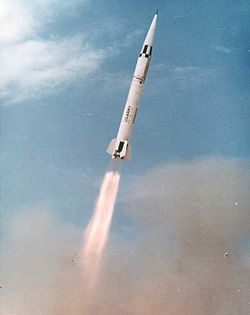| MGM-29 Sergeant | |
|---|---|
 Launch of a MGM-29 | |
| Type | Tactical ballistic missile |
| Place of origin | United States |
| Service history | |
| In service | 1962–1979 |
| Used by | United States Army German Army |
| Production history | |
| Designer | Jet Propulsion Laboratory |
| Designed | 1955 |
| Manufacturer | Sperry Utah |
| No. built | ~500 |
| Specifications | |
| Mass | 10,100 lb (4,600 kg) |
| Length | 34 ft 6 in (10.52 m) |
| Diameter | 31 in (79 cm) |
| Warhead | W52 (M65) nuclear |
| Blast yield | 200 kilotons of TNT (840 TJ) |
| Engine | Thiokol XM100 200 kN (45,000 lbf) |
| Propellant | Solid fuel |
Operational range | 75 nmi (139 km) |
| Boost time | 34 sec |
Guidance system | Inertial |
The MGM-29 Sergeant was an American short-range, solid fuel, surface-to-surface missile developed by the Jet Propulsion Laboratory. The missiles were built by Sperry Utah Company. The Sergeant was the third and last in a series of JPL rockets for the US Army whose names correspond to the progression in Army enlisted ranks, starting with Private and Corporal.
The Sergeant missile was first fired by an operational field artillery unit at White Sands New Mexico by the 3rd Battalion 38th Artillery station at Fort Sill Oklahoma in the summer of 1962. President John F. Kennedy attended the fire power demonstration at White Sands New Mexico.